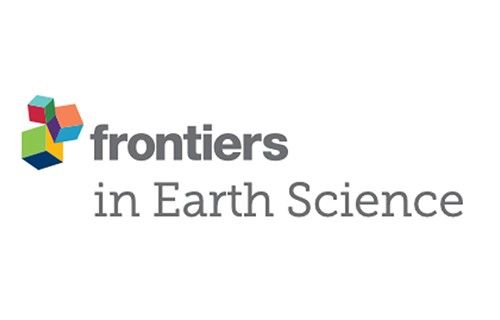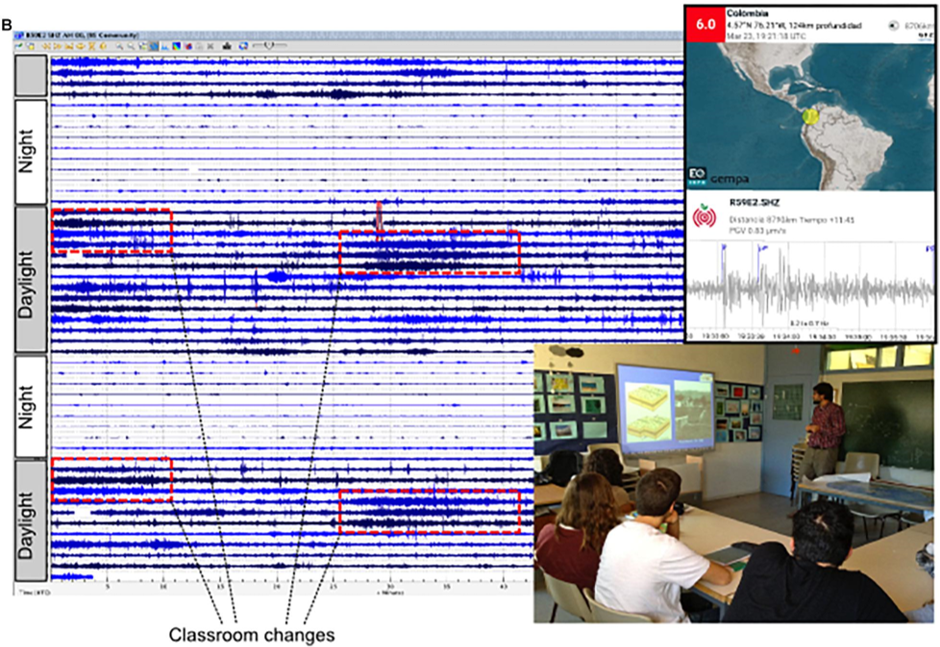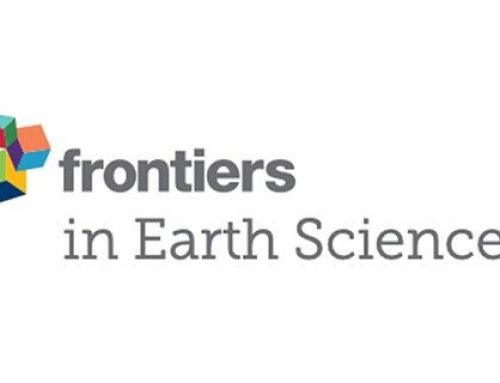Seismometers Within Cities: A Tool to Connect Earth Sciences and Society
By Jordi Diaz, Martin Schimmel, Mario Ruiz, and Ramon Carbonell

ABSTRACT
The high degree of human activities in urban environments produces large background vibrations that makes it difficult to use data acquired in these areas for classical seismology. Seismometers installed within cities have been typically been used for the study of seismic hazard or for monitoring civil engineering problems. However, with the development of monitoring techniques based on the interpretation of the so-called seismic ambient noise, these data have gained scientific interest. Our objective is to discuss an additional utility of seismometers deployed within a city; its use as a tool to connect society with Earth sciences. Many citizen activities, from traffic to music concerts, produce vibrations that can be recorded seismically, and our experience shows that these records attract the attention of the media and social networks. With the emergence of low-cost and easy-to-use instruments in recent years, more citizens can now record ground motion and become interested in the interpretation of the recorded seismograms. The installation of permanent seismic networks in educational centers has proven to be a good approach to introduce students to Earth sciences at the national level and can also be developed at the urban scale using this new instrumentation. In this contribution we will first review the previous results related to the identification of the sources of vibration in urban areas and then present a new ongoing project based on the deployment of a seismic network in educational centers located in the city of Barcelona.
EXCERPT
The Role of City Educational Seismic Networks
Seismic networks installed in educational centers have been developed throughout the world during the last decades. Some of the most successful examples are the different educational networks integrated in the project “Seismographs in school,” promoted by the Incorporated Research Institutions for Seismology (IRIS) in the United States1, the United Kingdom “Schools Seismology Network” administered by the British Geological Survey2, the Australian AuSIS network3, the french “Sismo à l’école” projects4 or the “Seismology in Schools” project managed by the Dublin Institute for Advanced Studies (DIAS) in Ireland5. These initatives have proven to be useful for connecting the students to Earth sciences, in particular in regions with moderate levels of seismic activity (e.g., Courboulex et al., 2012; Balfour et al., 2014). Data from some of these networks are nowadays distributed through the FDSNW service following the same protocol than for scientific networks.
In this contribution we want to present a new initiative carried out in Spain as part of a research project founded by the Spanish Ministry of Science, Research and Innovation. This network, installed during November 2019, has the particularity of having a high resolution scale, since it covers an area of approximately 10 km2 within the city of Barcelona with 14 temporary stations and integrating the five permanent sites already on duty. Twelve of the temporary sites have been installed in the premises of secondary schools, seeking to involve educational centers in the city to participate in the project. In return, students in those centers will be trained in the use of seismic instruments and the first analysis of the data. The objective is to close the gap between educational and research objectives, as the project aims to promote the knowledge on seismology and Earth Science among secondary school students, but also acquire data of scientific interest to investigate the feasibility of ambient noise studies in urban environments. The same project includes also the deployment of broad-band stations and high-resolution nodes in the eastern Pyrenees, to analyze the subsoil with similar methods but in a calmer environment.
Figure 2A shows a map view of the seismic stations that have been deployed in Barcelona. Red dots mark the new stations, while light and dark green dots show the available broad-band and accelerometric stations. The geometry of the network has been chosen to sample the main geological units of the Barcelona area. The network, expected to remain operative until the summer 2020, benefits from both professional three component short period instruments and one-component RaspberryShake (RS) seismometers equipped with 4.5 Hz6. It is planned that both kind of instruments will cover each site in different time periods to benefit from their respective advantages. Professional seismometers provide high quality data, but are difficult to be accessed in real time due to limitations in internet connectivity implemented in most educational centers for security reasons. The RS instruments have been designed to avoid these problems by transmitting the recorded data to an external data management center, an approach that makes easier the data collection for scientific objectives. However, as the data are sent through the network, they are more likely to contain gaps that can make it difficult to apply seismic methods based on the analysis of ambient seismic noise. It can be noted that RS instruments have been compared with geophones in field experiments with good results (Anthony et al., 2018).
With respect to the educational objectives of the project, the underlying idea is to use of the fascination power of earthquakes to introduce students in Earth Sciences and stimulate their motivation to continue learning using the multiple tools available online. Our experience shows that students are attracted to directly see how the waves from distant earthquakes shake the school building in a detectable way, a fact that seems obvious to Earth scientists, but that is surprising to people without training in this field. More generally, students will be introduced to the development of a research project, from its initial planning to the final presentation of the obtained results.
During the deployment of the seismometer in the secondary schools, an introductory talk is given to the students (Figure 2B), with the main objective of increasing their curiosity about issues related to seismology and, in particular, how seismic waves are recorded and what information can be retrieved from their study. The research team has a long tradition in dissemination projects, because since 2009 it has been regularly offering a workshop named “Looking for Earthquakes” to secondary schools in and around Barcelona. This introductory talk is complemented in this case by a hands-on session in which the data acquired in each school are inspected. Students first notice the day/night and business day/weekend variations of the background noise, as well as the noise variations directly related to the scholar activity; e.g., the intervals of about 5 min of higher amplitude correspond to the classroom changes that students usually make every hour (Figure 2B). These observations can be used to develop students’ abilities to read and interpret graphs, propose hypotheses to explain the data and seek additional information to validate or not the hypothesis. Students can also investigate aspects directly related to Earth sciences, as the distribution and rate of occurrence of earthquakes, their relationship with plate tectonics, the concepts of intensity and magnitude and the aspects related to seismic hazards, all of them elements included in the official curricula. The students are invited to use phone apps as EqInfo7, which allow them to track in real time seismic detections in the network stations (Figure 2B). The research team will support the centers most committed to the project with guidance and appropriate software tools so that students can locate earthquakes and study the propagation of seismic waves.
The degree of involvement of each school will vary depending on their respective pedagogical plans. For example, the installation of the seismic network can be used to implement transversal educational projects that involve not only the natural sciences, but also physics, technology, and even social sciences. Seismometers can be used to study the pendulum laws, electromagnetic induction, elastic wave propagation or frequency analyses. The network can also be a motivation to develop technological projects with the objective of designing in-house seismometers based in existent and affordable elements and to develop programing exercises for processing the recorded data. Finally, aspects related to social sciences, including the economic aspects of seismic risk or the historical interest of the most reputed philosophers in the origin of earthquakes and the Earth internal structure can also be addressed. The scientific team will provide support to the centers that decide to carry out this type of initiatives.
With respect to the scientific objective of the Barcelona scholar seismic network, the acquired data will be first used to map in detail the sources of vibrations around the city, an information that is relevant to check its applicability for tomographic investigations (e.g., Yang and Ritzwoller, 2008). The data will be used to verify and expand the MHVSR studies already available in the Barcelona zone (Cadet et al., 2011 and references therein). Having continuous records for several months will make it possible to verify whether temporal variations in background noise can affect the MHVSR measurements. Salinas et al. (2014) have already pointed that f0 resonance peaks retrieved from MHVSR studies can vary strongly between very close sites and Macau et al. (2015) have also observed that some locations in the Barcelona conurbation present two HVSR peaks, which makes it difficult to determine what the representative value for engineering studies is.
Finally, we plan to use also the data to test the applicability of the methods based on Rayleigh wave ellipticity inversion (e.g., Berbellini et al., 2019) and ambient noise tomography (e.g., Nuñez et al., 2019) in an urban environment. Since the noise tomography approach relies on a diffusive noise wave field, that is, without directivity, it is not clear whether or how well it can be used in an active environment such as Barcelona. However, the characterization of the sources discussed previously may help to select appropriate time windows and hence allow to extract inter-station surface wave Green’s functions as required for the tomographic images of the shallow structure beneath Barcelona. Although the viability of such approaches is medium/low, if the data allows to obtain tomographic images on the subsurface levels below a city, this will have a high impact in hazard and risk assessment. Therefore, this task can be considered as a high risk/high impact study.

Figure 2B. Example of seismic records in a secondary school in Barcelona (1 h per line) clearly showing the day/night variations and the scholar activity pattern; red dashed boxes show the 5 min-long periods of larger noise observed every hour during classroom changes. The upper side panel shows an example of the seismic alerts that can be received by the students using mobile phone apps, while the lower side panel illustrates the dissemination talks given in schools.
CONCLUDING REMARKS
Although the most obvious way to involve citizen to Earth sciences is to share information about the local effects of natural seismicity, other forms of involvement can be explored. We propose here to focus the attention on secondary schools students by installing seismometers in their centers and involve the students in their management, with the ultimate goal of developing their curiosity about the sources of the recorded vibrations and, in general, providing hypotheses to explain data.
We are convinced that this can be a positive approach to increase the interest of society toward Earth sciences, in particular in countries not often affected by large earthquakes. The presence of Earth sciences in the curricula of secondary education has been decreasing in recent years in Spain and we believe it is urgent to promote actions to attract students’ attention to this field.
Our experience has shown that we can have a relatively high impact on social networks (Twitter, Facebook, Instagram) and mass media by unraveling and making the public aware that seismic sensors can detect activities such as traffic, subway trains or citizen activities as football games, music concerts or fireworks. We believe that attracting the attention of the public is of maximum interest for the future of our research field.
In addition to these aspects related to dissemination, we expect that data obtained by citizen networks installed in educational centers within the city of Barcelona can be useful from a scientific point of view, as the characterization of the sources of background vibrations in urban environments is of great interest to study the seismic structure beneath pavements and buildings using ambient noise data and hence make possible a better imaging of the geology beneath the city and an improving of the available seismic hazard maps.
Download the complete paper from Jordi Diaz, et al. and published in Frontiers in Earth Science.
From all of us at Raspberry Shake we would like to thank each of the authors of this paper.

